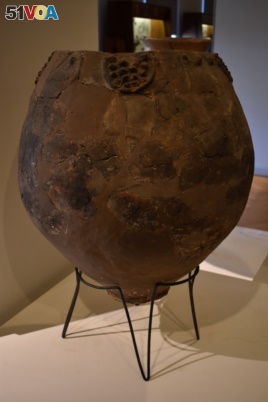14 November, 2017
This is What's Trending Today...
The United States, France and Germany may be the top three wine-drinking countries in the world, but Georgia can now claim to be the country where wine-making began.
And, it turns out, humans have been making and enjoying the alcoholic drink for a lot longer than we had thought.
Scientists this week announced the discovery of the oldest-known evidence for wine-making.
Researchers found pieces of 8,000-year-old containers used to make wine. The remains were found at two sites about 50 kilometers south of Tbilisi, the capital of Georgia.
The findings show that wine-making occurred earlier than previously known in the South Caucasus area. Before now, the oldest evidence had come from pottery from the Zagros Mountains in northwestern Iran, dating to 5400-5000 BC.
The oldest of the newly discovered remains dated to about 5980 BC. The jars measured about 80 centimeters tall and 40 centimeters wide. They were gray, some with simple drawings of grapes and of a man dancing.

A Neolithic jar, possibly a Neolithic qvevri used for brewing wine from the site of Khramis Didi Gora south of Tbilisi on display at the Georgian National Museum is seen in this handout photo received November 13, 2017. Judyta Olszewski/Handout via REUT
The researchers published their findings in the Proceedings of the National Academy of Sciences.
David Lordkipanidze is director of the Georgian National Museum, which helped pay for the research. He said large jars called qvevri -- similar to the ancient ones -- are still used by winemakers in Georgia today.
Researchers performed biochemical tests on the jars to find small amounts of wine substance that the pottery had absorbed.
University of Pennsylvania's Patrick McGovern is a biomolecular archaeologist. He found evidence of several kinds of acid that indicate brewing involving the Eurasian grape.
The pottery was found at the site of two ancient villages, once home to about 60 people. The villagers harvested wheat, raised animals and used simple tools made of bone and volcanic glass.
This is not the earliest sign of any alcoholic beverage. Evidence was found in China of an alcoholic mix of rice, honey and fruit from about 7000 BC.
And that's What's Trending Today.
Reuters news agency reported this story. Ashley Thompson adapted it for Learning English. Hai Do was the editor.
_______________________________________________________________
Words in This Story
wine - n. an alcoholic drink made from the juice of grapes
pottery - n. objects (such as bowls, plates, etc.) that are made out of clay usually by hand and then baked at high temperatures so that they become hard
jar - n. a clay container that has a wide opening
absorb - v. o take in (something, such as a liquid) in a natural or gradual way
acid - n. a chemical with a sour taste that forms a salt when mixed with a base
archaeologist - n. a person that studies archaeology -- the science that deals with past human life and activities by studying the bones, tools, etc., of ancient people
grape - n. a green, dark red, or purplish-black berry that is used to make wine or is eaten as a fruit